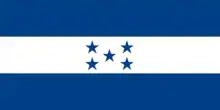Honduran diaspora
Since 1975 emigration from Honduras has accelerated as economic migrants and political refugees seek a better life elsewhere. Although many Hondurans have many relatives in Nicaragua, Spain, Mexico, El Salvador and Canada, the majority of Hondurans living abroad are in the United States.


Nowadays, most Hondurans migrate because of the political persecution, unemployment, and poverty that has affected the country since the 1990s. However, many Hondurans have succeeded abroad; examples include Steve Van Buren, Sir. Salvador Moncada, Carlos Mencia, Henry Flores, and Gerald Young.
Countries
The United States

According to the U.S. Census Bureau (figures taken at the 2005 census) 460,000 Hondurans live there, making them the third largest Central American community in the U.S. Members of the Honduran community live mainly in: Florida-88,000 (24,000 in Miami alone), 68,000 in Texas (27,000 in Houston and 6,000 in Dallas), 62,000 in California (25,000 in the city of Los Angeles), 51,000 in New York (36,000 in New York City), 55,000 in Louisiana (54,000 in New Orleans), 25,000 in New Jersey, 18,000 in Virginia, and 3,000 in Washington DC.
2012 US State Department estimates[1] suggested there are between 800,000 and 1 million Hondurans living in the United States, nearly 15% of the Honduran domestic population. The large uncertainty is due to the substantial number of Hondurans living illegally in the United States. The 2010 U.S. Census counted 633,401 Hondurans in the United States, up from 217,569 in 2000.[2]
Spain

On October 3, 1963, the then President of Honduras Dr. Ramón Villeda Morales and his wife Alejandrina Bermúdez Milla, visited Spain on the occasion of the change of Honduran Ambassador, Antonio Bermúdez for Virgilio Zelaya Rubí; Villeda Morales also met with Hondurans residing in the European nation, among them were: Harold Aldana, Jorge Rápalo, Luis Alberto Ponce, Óscar Ziri Zúñiga, Rubén Villeda.
On March 14, 1966, the Resolution on the Hispanic-Honduran Cultural Agreement2 is issued in which the Cultural Treaty between Hispano-Honduran dated October 22, 1958 is discussed and in which the citizens of both countries are exonerated from the payment of enrollment, exams and degrees when they enroll in educational centers in a country other than their own.
There were 100,000 Hondurans living in Spain in 2018.[3]
The Americas
According to statistics compiled by CELADE (Investigación Migración Internacional de Latinoamérica) in 1992 there were more than 8,700 Hondurans living in El Salvador, 9,700 in Nicaragua (by 1995), 5,500 in Guatemala (by 2002), 3,000 in Costa Rica (by 2000); and 2,400 in Belize (by 1990). Additionally, according to the UN Demographic Yearbook (2000) 8,700 Hondurans live in Canada. There's another population of 80,587 in Mexico (by 2018).
See also
References
- U.S. Relations With Honduras. State.gov (2012-06-19). Retrieved on 2013-01-04.
- U.S. Census website. Factfinder2.census.gov. Retrieved on 2013-01-04.
- La otra 'trata de blancas': así operan las mafias hondureñas en España. elconfidencial.com (2018-07-17). Retrieved on 2018-10-32.